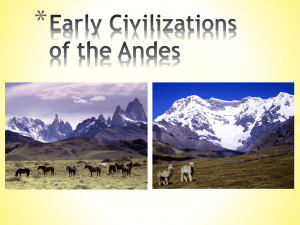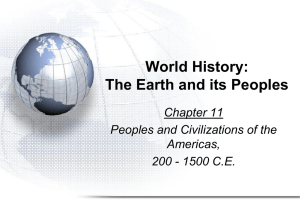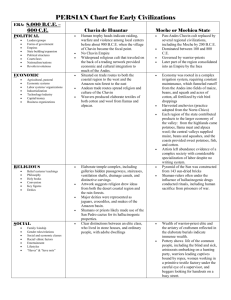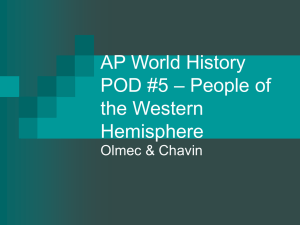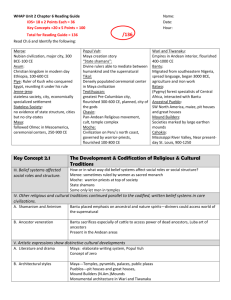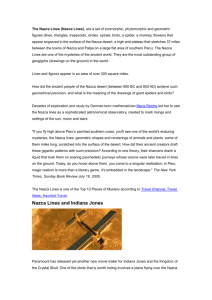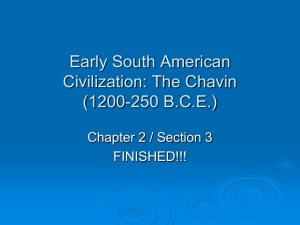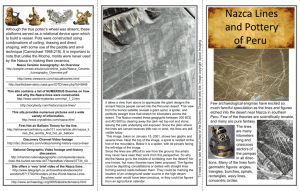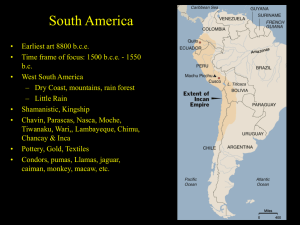Pre- inca cultures in central Andes
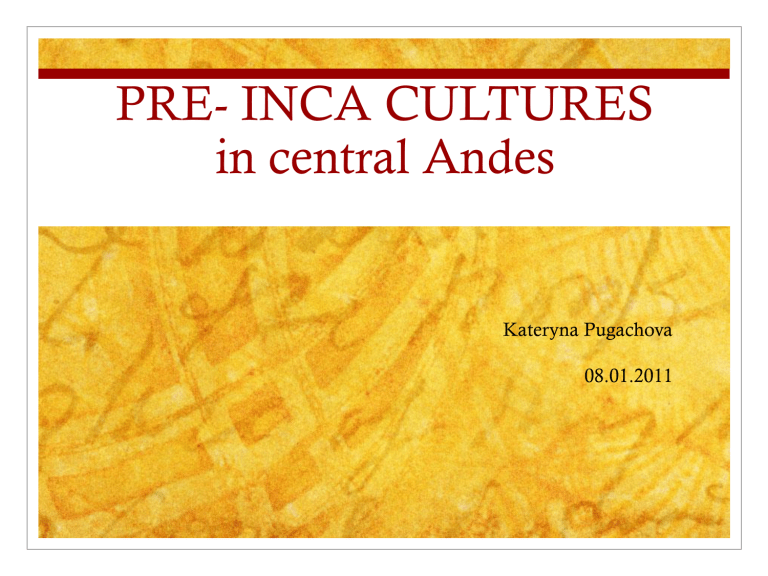
PRE- INCA CULTURES in central Andes
Kateryna Pugachova
08.01.2011
Before the spreading of Inca Impair a lot of other different cultures occupied that territory. The most known of them are:
Chavin (1000 BC- 500 AD)
Moche (200 BC- 700 AD)
Nazca (200 BC- 600 AD)
Tiwanaku (300 AD-1000 AD)
Wari (800 AD- 1000 AD)
Chimu (1000 AD- 1466 AD)
First horizon:
Second horizon:
Chavin culture
The most known are the ruins of Chavin de Huantar temple. To protect it from the damage caused by an annual flood people created the drainage system around and even under the temple.
Chavin started to use metals. Even thou the metallurgy was primitive they created magnificent golden jewelry.
.
Chavin’s architecture
Chavin’s sculptures
Moche culture
Moche were not politically organized as an empire or state. They were more like a group of autonomous polities that shared a common culture.
Mocha people as first started to make polish ceramics on which they carved scenes from there life and household.
They believed in god of sun and moon and built pyramids in honor of there gods. During the rituals human sacrifice, cannibalism and blood-drinking took place.
Nazca culture
They created the famous Nazca lines and built an impressive system of underground aqueducts that still function today.
The Nazca culture is widely known for its fine polychrome ceramics with representations of fruit, animals, human personages, and hybrid beings.
It is also known for the textiles. They began using llama and alpaca a thousand years before the north coast cultures realized that camelid wool can me manufactured.
Nazca lines
Tiwanaku culture
Some believe Tiwanaku is the oldest city in the world.
Others believe it was built by an extraterrestrial race who also created the Nazca Lines.
Tiwanaku’s location between the lake and dry highlands provided key resources of fish, wild birds, plants, and herding grounds llamas. The Titicaca
Basin is the most productive environment in the area with predictable rainfall, which the Tiwanaku culture learned to harness and use in their farming
Architecture
Tiwanaku monumental architecture is characterized by large stones of exceptional workmanship. The blocks have flat faces that do not need to be fitted upon placement because the grooves make it possible for the blocks to be shifted by ropes into place. The most important place is Kalasasaya temple. It is built like a stockade with 12 foot high columns jutting upward at intervals, each of these being carved into human figures. The largest terraced step pyramid of the city, the Akapana, was once believed to be a modified hill. Within many of the sites structures are impressive gateways. The so-called Gate of the Sun is a megalithic solid stone arch. Some historians and archaeologists believe that the central figure represents the “Sun God”.
Wari culture
The Wari people were the first to use military force to conquer the surrounding states. After conquering another people, as in most conquests, the Wari subdued the old cultures and enforced their own way of life forbidding any practice of the former culture.
There is evidence that much of the Inca culture came from the ideas of the Wari people. The Wari people had made up an extensive road system which is the basis for the Incan system of transportation. The Wari people also built strong, stone buildings that had a ventilation system and were earthquake resistant. Another interesting building excavated by National Geographic, was an underground tomb found near the ancient capital Wari that was dug out in the shape of a llama and lined with smooth rocks.
Chimu culture
The Chimú were known to have worshipped the moon, unlike the Inca, who worshiped the sun. The Chimu viewed the sun as a destroyer.
The Chimú are best known for their distinctive monochromatic pottery and fine metal working of copper, gold, silver, bronze. The pottery is often in the shape of a creature, or has a human figure sitting or standing on a bottle.
The majority of Chimú textiles were made from alpaca wool
http://chavin.perucultural.org.pe/index.htm
http://enloehs.wcpss.net/projects/candc/merg/rbmwrnmerg7/rdnmawrebmerg7
.htm
http://www.bbc.co.uk/sn/tvradio/programmes/horizon/peru_prog_summary.sh
tml
http://www.crystalinks.com/nazca.html
http://www.mnsu.edu/emuseum/prehistory/latinamerica/south/cultures/nazca
.html
http://www.lost-civilizations.net/inca-tiahuanaco-deluge.html
http://www.crystalinks.com/preinca.html
http://www.mnsu.edu/emuseum/cultural/southamerica/wari.html
http://www.about-peru-history.com/chimu-culture.html

